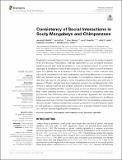Files in this item
Consistency of social interactions in sooty mangabeys and chimpanzees
Item metadata
| dc.contributor.author | Mielke, Alexander | |
| dc.contributor.author | Preis, Anna | |
| dc.contributor.author | Samuni, Liran | |
| dc.contributor.author | Gogarten, Jan F | |
| dc.contributor.author | Lester, Jack D | |
| dc.contributor.author | Crockford, Catherine | |
| dc.contributor.author | Wittig, Roman M | |
| dc.date.accessioned | 2021-11-08T18:30:03Z | |
| dc.date.available | 2021-11-08T18:30:03Z | |
| dc.date.issued | 2021-01-22 | |
| dc.identifier | 276614515 | |
| dc.identifier | 8d90805a-9ee2-4d00-af69-3945bdcdcde3 | |
| dc.identifier | 85100534878 | |
| dc.identifier.citation | Mielke , A , Preis , A , Samuni , L , Gogarten , J F , Lester , J D , Crockford , C & Wittig , R M 2021 , ' Consistency of social interactions in sooty mangabeys and chimpanzees ' , Frontiers in Ecology and Evolution , vol. 8 , 603677 . https://doi.org/10.3389/fevo.2020.603677 | en |
| dc.identifier.issn | 2296-701X | |
| dc.identifier.other | Bibtex: mielke2021consistency | |
| dc.identifier.uri | https://hdl.handle.net/10023/24292 | |
| dc.description | AM, AP, LS, CC, and RW were supported by the Max Planck Society; AM was supported by the Wenner Gren Foundation (Grant Number 9095) and the British Academy Newton International Fellowship; AP was supported by the Leakey Foundation; LS was supported by the Minerva Foundation; JG was supported by an NSF Graduate Research Fellowship (DGE-1142336), the Canadian Institutes of Health Research's Strategic Training Initiative in Health Research's Systems Biology Training Program, an NSERC Vanier Canada Graduate Scholarship (CGS), and a long-term Research Grant from the German Academic Exchange Service (DAAD-91525837-57048249). CC was supported by the European Research Council (ERC) under the European Union's Horizon 2020 research and innovation programme (grant agreement no. 679787). RW was supported by DFG Researcher Unit (FOR 2136) Sociality and Health in Primates (WI 2637/3-1). Research at the Taï Chimpanzee Project has been funded by the Max Planck Society since 1997. | en |
| dc.description.abstract | Predictability of social interactions can be an important measure for the social complexity of an animal group. Predictability is partially dependent on how consistent interaction patterns are over time: does the behavior on 1 day explain the behavior on another? We developed a consistency measure that serves two functions: detecting which interaction types in a dataset are so inconsistent that including them in further analyses risks introducing unexplained error; and comparatively quantifying differences in consistency within and between animal groups. We applied the consistency measure to simulated data and field data for one group of sooty mangabeys (Cercocebus atys atys) and to groups of Western chimpanzees (Pan troglodytes verus) in the Taï National Park, Côte d'Ivoire, to test its properties and compare consistency across groups. The consistency measures successfully identified interaction types whose low internal consistency would likely create analytical problems. Species-level differences in consistency were less pronounced than differences within groups: in all groups, aggression and dominance interactions were the most consistent, followed by grooming; spatial proximity at different levels was much less consistent than directed interactions. Our consistency measure can facilitate decision making of researchers wondering whether to include interaction types in their analyses or social networks and allows us to compare interaction types within and between species regarding their predictability. | |
| dc.format.extent | 11 | |
| dc.format.extent | 3451659 | |
| dc.language.iso | eng | |
| dc.relation.ispartof | Frontiers in Ecology and Evolution | en |
| dc.subject | Chimpanzee | en |
| dc.subject | Sooty mangabey | en |
| dc.subject | Social complexity | en |
| dc.subject | Sociality | en |
| dc.subject | Consistency | en |
| dc.subject | Replicability | en |
| dc.subject | QL Zoology | en |
| dc.subject | DAS | en |
| dc.subject.lcc | QL | en |
| dc.title | Consistency of social interactions in sooty mangabeys and chimpanzees | en |
| dc.type | Journal article | en |
| dc.contributor.institution | University of St Andrews. School of Psychology and Neuroscience | en |
| dc.identifier.doi | https://doi.org/10.3389/fevo.2020.603677 | |
| dc.description.status | Peer reviewed | en |
This item appears in the following Collection(s)
Items in the St Andrews Research Repository are protected by copyright, with all rights reserved, unless otherwise indicated.

